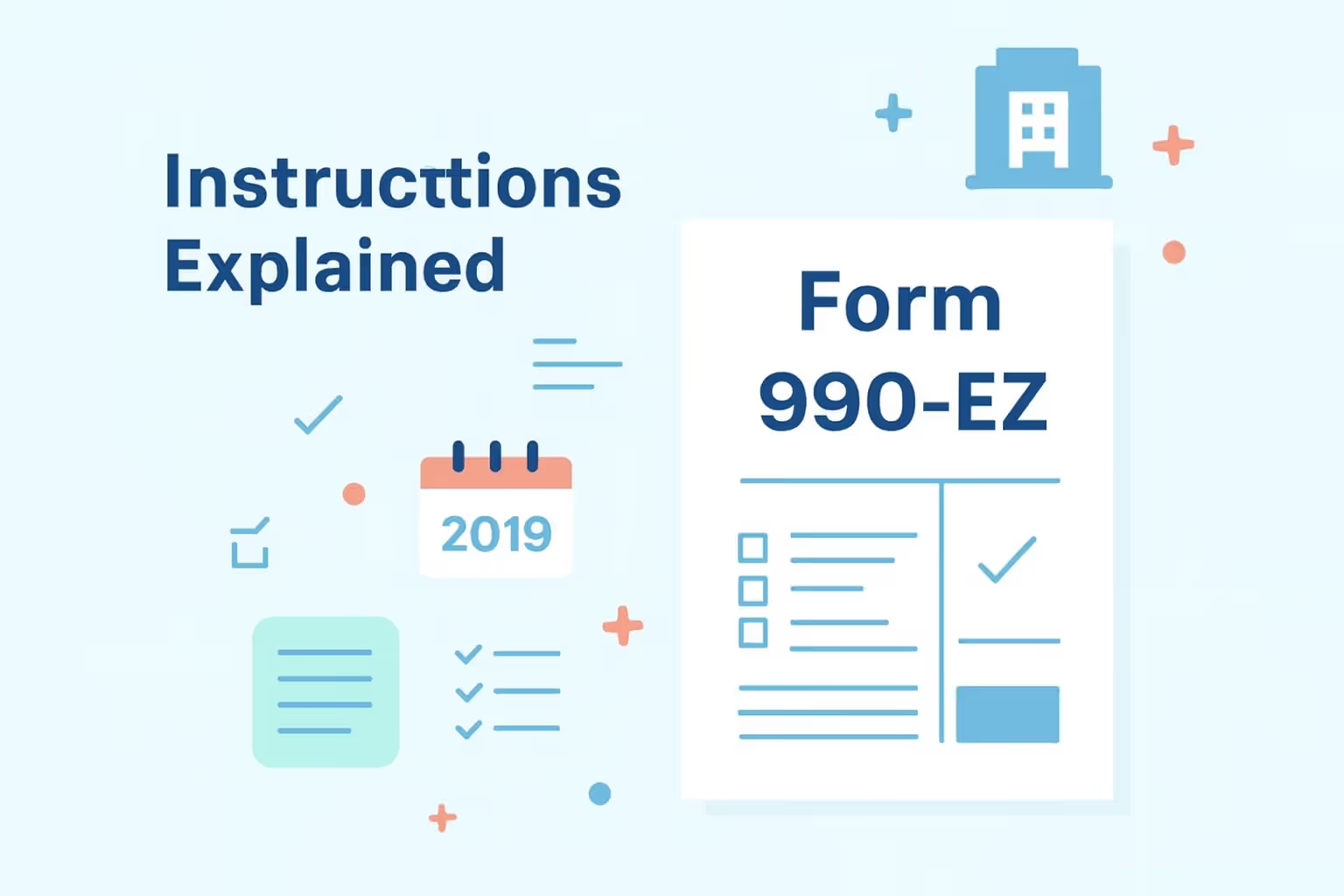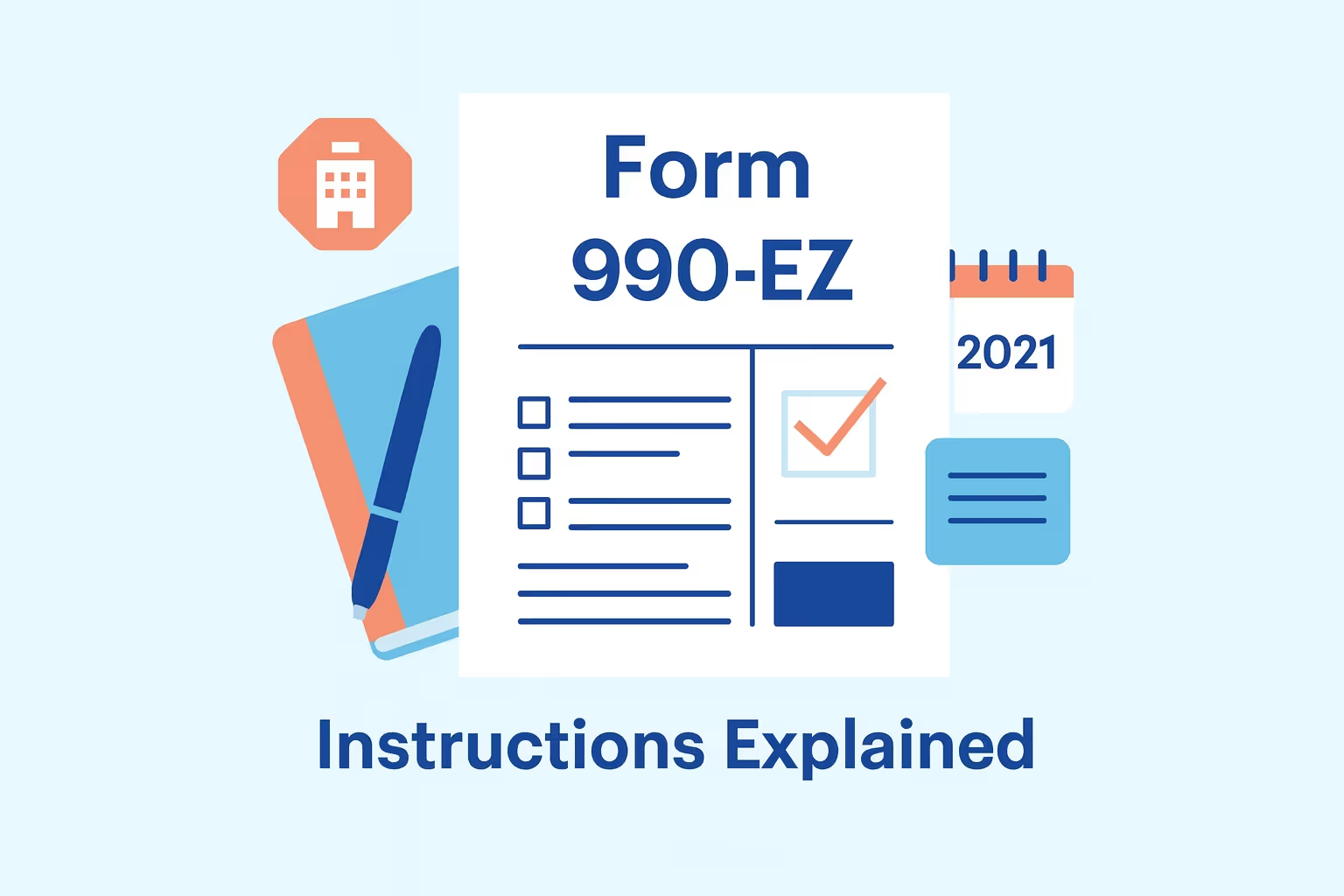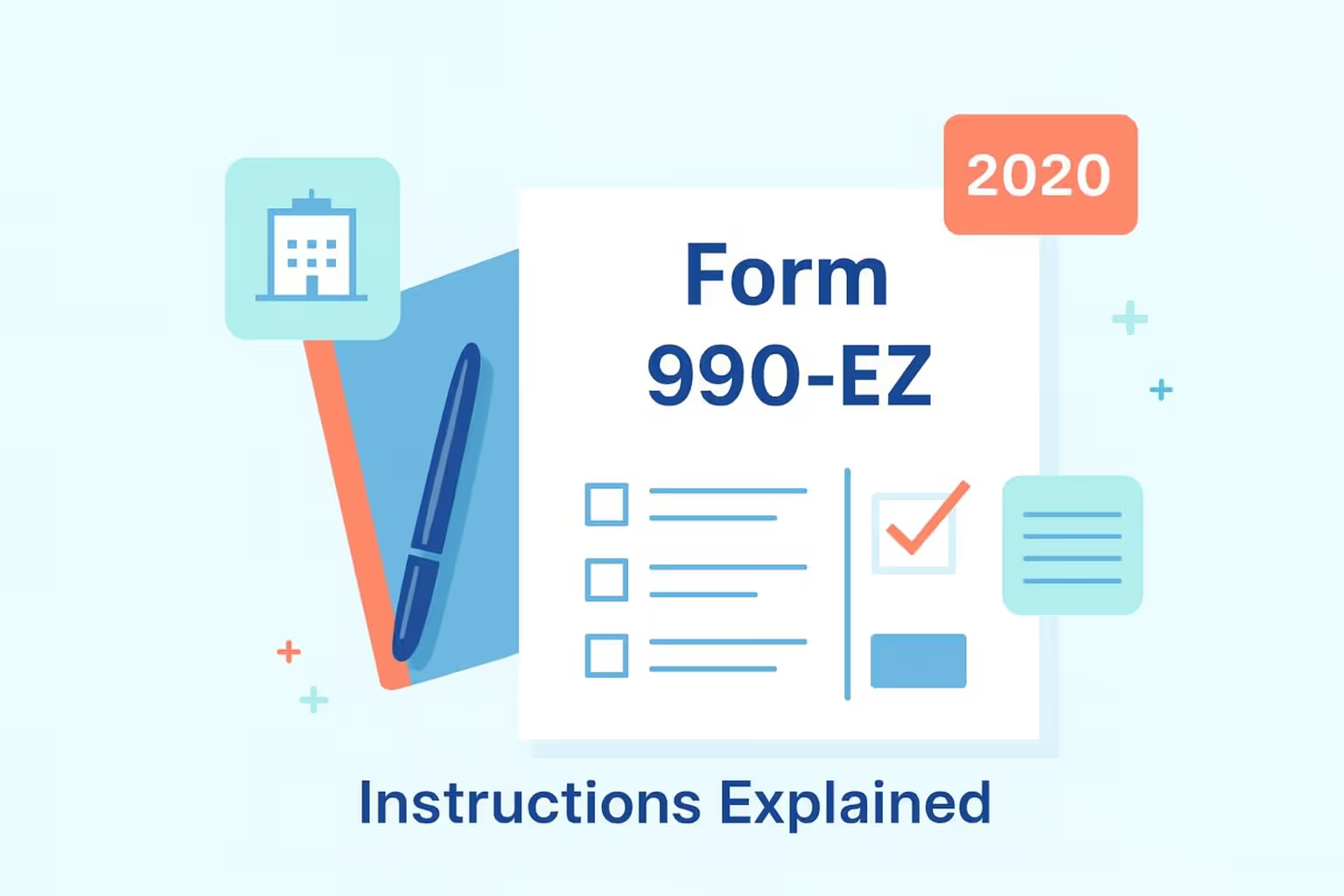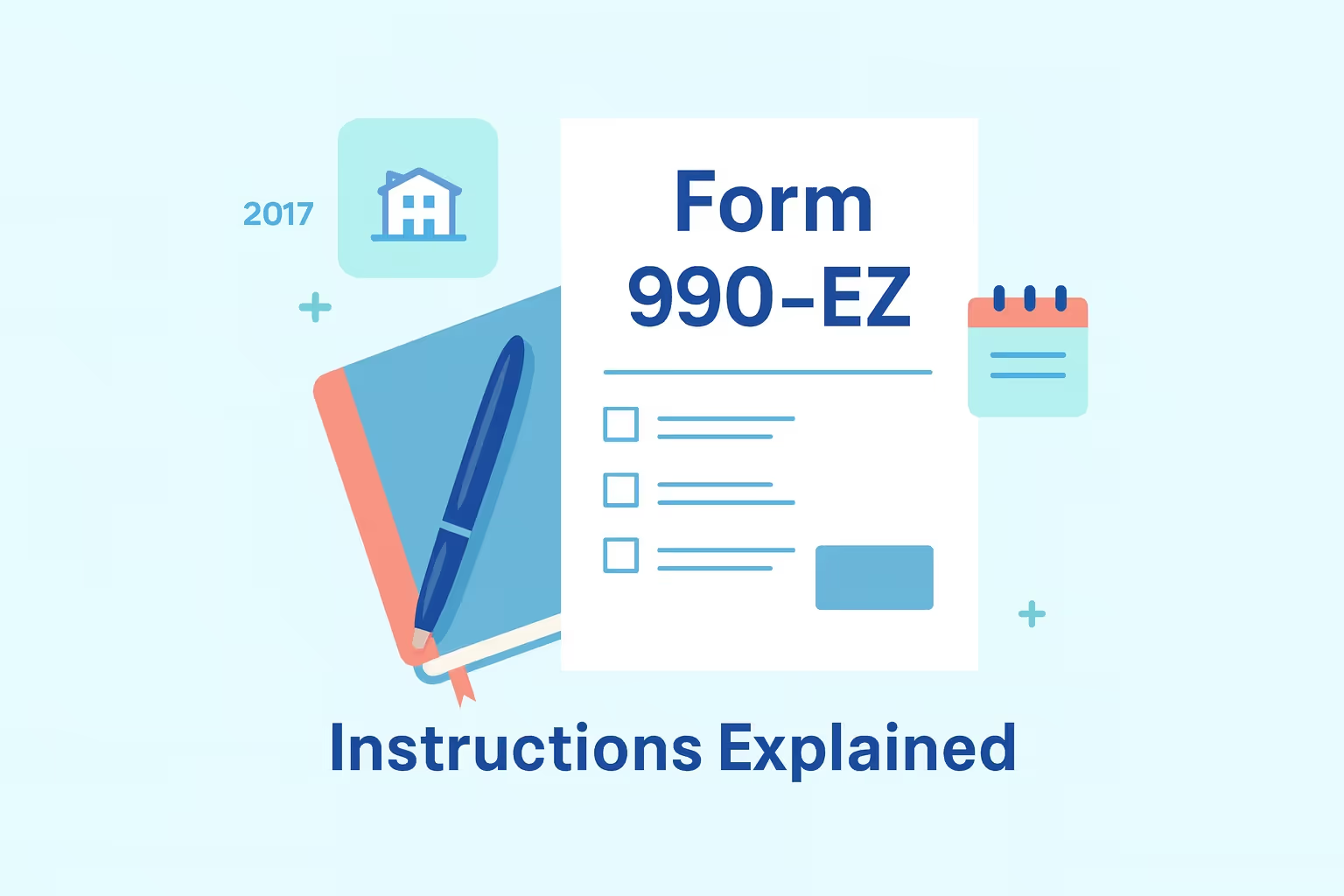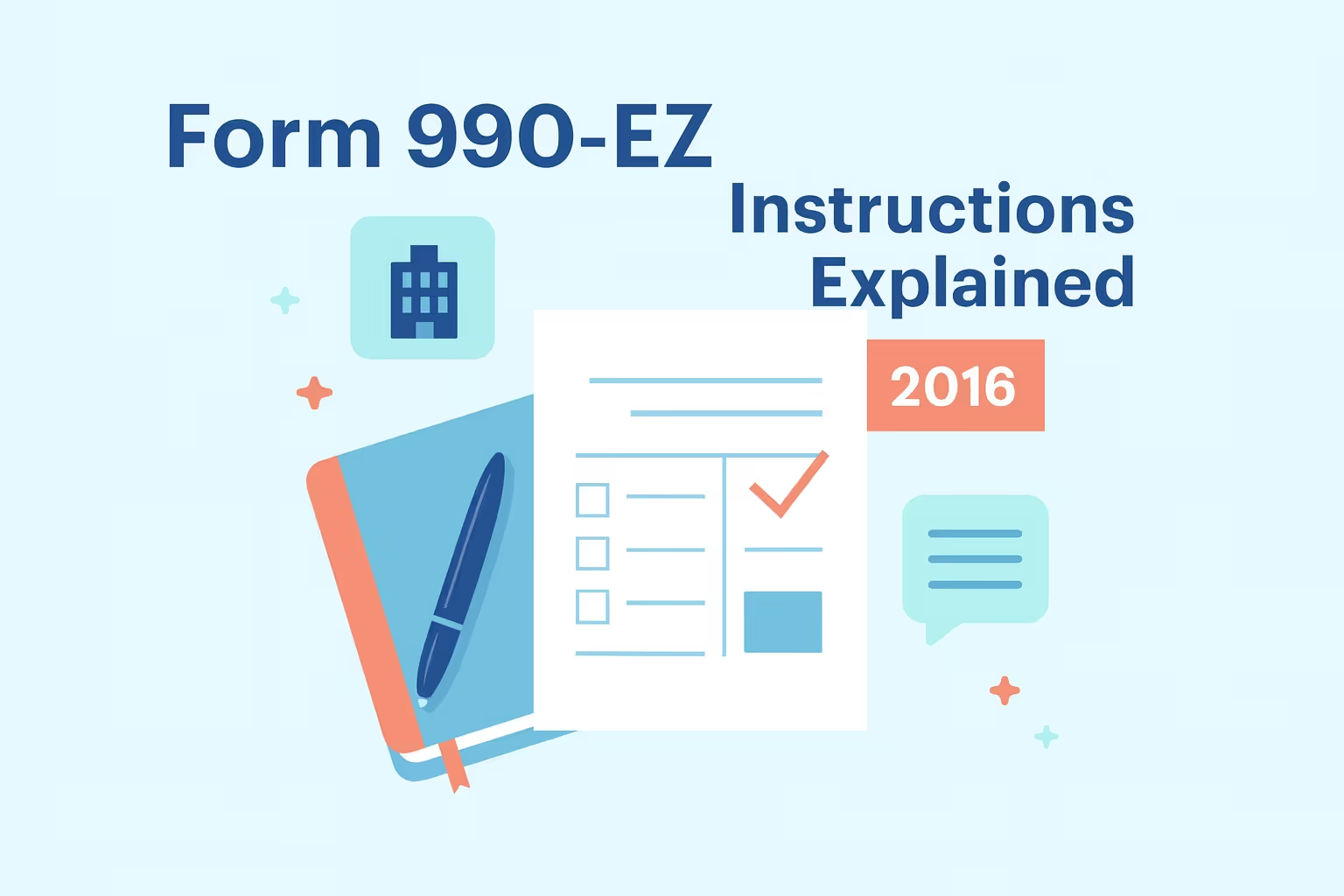How to File Federal Form 990-EZ for Tax Year 2024
For every tax-exempt organization, filing Federal Form 990-EZ for Tax Year 2024 is more than an administrative task: a public statement of accountability. Thousands of nonprofits use this form yearly to show donors, regulators, and the public how funds are managed and missions are fulfilled. Completing it accurately reinforces trust and demonstrates professional financial stewardship.
Timely, electronic filing is now mandatory and offers clear advantages. Organizations that prepare early avoid the stress of last-minute errors, missing attachments, or rejected submissions. E-filing ensures faster processing, fewer delays, and quicker public availability of your completed form on the IRS website. The sooner your return is accepted, the sooner your team can focus again on serving your community instead of managing compliance concerns.
This guide walks you through everything required to complete Form 990-EZ: from confirming eligibility and understanding schedules to reporting program service accomplishments and net assets. Whether you lead a small community nonprofit or a growing association with multiple programs, this article will help you safeguard your tax-exempt status, file confidently, and present your organization’s impact clearly and accurately.
Who Should Use Federal Form 990-EZ for Tax Year 2024?
Filing the correct annual return is essential for maintaining your organization’s good standing and tax-exempt status. The Federal Form 990-EZ for Tax Year 2024 is specifically designed for small to mid-sized nonprofits that meet certain financial thresholds. It balances detail and simplicity, giving the IRS and the public a transparent look at your financial position without the complexity of the complete Form 990.
Eligibility and Size Thresholds
- Financial Criteria: You may file Form 990-EZ if your organization’s gross receipts are less than $200,000 for the tax year and your total assets are under $500,000 at year-end. Crossing either threshold means you must file Form 990 instead.
- Tax Year Alignment: Calendar-year organizations will use the 2024 form for activities from January 1 through December 31, 2024. Fiscal-year organizations must file the version of the form that begins within their tax year.
Organizations That Must Not Use 990-EZ
- Excluded Filers: Private foundations, donor-advised fund sponsors, hospitals, Section 501(c)(29) health insurance issuers, and certain controlling entities must use Form 990.
- Exceptional Cases: Religious organizations exempt from filing remain exempt unless engaged in unrelated business income or other taxable activities.
Public Disclosure and Transparency
- Public Record: A completed Form 990-EZ becomes publicly available. Avoid including personal identifiers such as Social Security numbers.
- Key Details: Always verify your organization’s name, employer identification number, and business address. Accurate organization details ensure consistency across IRS records and funding applications.
990-EZ vs 990 vs 990-N: Which Return Fits Your Organization’s Activities
Before you start filling out IRS forms, confirming that Federal Form 990-EZ for Tax Year 2024 is the right one for your organization is critical. Filing the correct version prevents rejection, ensures compliance with the Internal Revenue Code, and demonstrates financial responsibility to donors and regulators.
Return Selection at a Glance
- Gross Receipts: ≤ $50,000
- Total Assets: N/A
- Required Schedules: None
- Typical Filers: Very small organizations with minimal activity
- Public Charity Status Proof: Not required
- Processing Time: 24–48 hours
- Gross Receipts: < $200,000
- Total Assets: < $500,000
- Required Schedules: Several conditional schedules (A, B, C, etc.)
- Typical Filers: Small to mid-size nonprofits
- Public Charity Status Proof: Yes
- Processing Time: 1–2 weeks
- Gross Receipts: ≥ $200,000 or Total Assets ≥ $500,000
- Required Schedules: Many required schedules
- Typical Filers: Large nonprofits, hospitals, donor-advised fund sponsors
- Public Charity Status Proof: Yes
- Processing Time: 2–4 weeks
This outlines how gross receipts and total assets determine which form applies. Each return provides progressively more detail about program service revenue, net assets, and public support.
Real-World Scenarios to Guide Your Decision
- Small Cultural Group Example: A community arts trust with annual gross receipts of $40,000 can file Form 990-N but might voluntarily file Form 990-EZ to demonstrate transparency to potential donors. Doing so can improve credibility with grantmakers who request detailed financial documentation.
- Growing Health Organization Example: A clinic with $180,000 in receipts and $520,000 in assets must file Form 990 because the asset threshold disqualifies it from using Form 990-EZ. Accuracy here prevents penalties for filing the wrong return.
- Parent-Subsidiary Example: A local association operating under a group exemption number may still need to file separately if its activities differ from those reported by the parent corporation trust association. Always check with the IRS website or the central organization before filing.
Pre-Filing Checklist and Data You Must Gather
Preparation is the key to completing Federal Form 990-EZ accurately for Tax Year 2024. Having the correct records and governance documents ready will streamline your filing process, minimize mistakes, and ensure your information matches what the IRS and donors expect.
Core Identification and Governance
- Organizational Identity: Gather your employer identification number, business address, legal name, and group exemption number if applicable. Verify these details against your governing documents to ensure accuracy before submission.
- Leadership Information: Confirm the names, titles, and responsibilities of your officers, including the vice president, chief accounting officer, and any paid preparer. Consistency between your records and IRS forms helps prevent delays or verification requests.
- Foundational Records: Assemble your articles of incorporation, bylaws, board meeting minutes, and other governing documents. These establish your organization’s exempt purpose and show compliance with IRS requirements.
Financial Source Documents
- Income and Expense Records: Gather bank statements, receipts, invoices, and payroll records that reflect all the expenses, wages paid, and other compensation for key employees. This data will support the amounts listed on your balance sheet and income sections.
- Benefit and Investment Details: Include documentation of health benefits, deferred compensation, and investment income. Accurate records of tax-exempt interest, program service revenue, and initiation fees will ensure precise reporting.
- Revenue Activity Reports: Collect records of gaming and fundraising events, capital contributions, and foreign financial accounts. These activities may trigger specific schedules or disclosures.
Specialized Disclosures and Attachments
- Related Party and Compliance Data: Identify any excess benefit transaction, controlled entity relationship, or interested person activity during the year. Proper reporting prevents penalties and excise tax-imposed issues.
- Other Compliance Considerations: Note any previously reported significant activities or changes to your organization’s primary exempt purpose. If your organization engaged in political campaign activities, confirm whether you must include Schedule C or related attachments.
Step-by-Step: Completing Parts I to V of Form 990-EZ
Once your records are organized, you can complete Federal Form 990-EZ for Tax Year 2024. Each section builds a financial narrative that confirms your organization’s transparency and compliance. Review every line carefully; accuracy here protects your tax-exempt status and strengthens donor confidence.
Part I: Revenue, Expenses, and Net Assets
- Revenue Entries: List all sources of income, including contributions, program service revenue, investment income, and tax-exempt interest. Enter these amounts separately so reviewers can see the organization’s full scope of activity.
- Expense Reporting: Enter all the expenses related to operations, grants, salaries, and administrative costs. Avoid netting revenues against expenses; the IRS requires gross reporting to maintain clarity.
- Net Asset Calculation: To determine net income, subtract total expenses from total revenue. Add or subtract prior-year net assets to show how the financial position has changed across current and previous years.
Part II: Balance Sheet and Fund Balances
- Balance Accuracy: Record total assets, liabilities, and fund balances at the beginning and end of the tax year. These figures must match your organization’s net assets in Part I.
- Asset Valuation: Use cost basis for land, buildings, or equipment rather than market value. This ensures compliance with IRS instructions and prevents inconsistencies in future filings.
Part III: Program Service Accomplishments
- Narrative Reporting: Describe your organization’s activities and largest program services in clear, measurable terms. Include statistics, community outcomes, or client impact.
- Transparency in Results: Explain how your programs fulfill your organization’s primary exempt purpose. This section demonstrates accountability to donors and regulators.
Part IV: Officers, Directors, and Key Employees
- Compensation Details: List names, titles, hours worked, wages paid, and health benefits for key employees and the highest compensated independent contractors. Include deferred compensation and other compensation where applicable.
- Zero Entries: If any officers are unpaid, enter “0” instead of leaving the field blank. This ensures that the completed form is accepted without errors.
Part V: Other Information and Compliance Checks
- Compliance Questions: Review unrelated business income, political campaign activities, or significant asset dispositions. Each “Yes” answer may require a supporting schedule.
- Signatures and Verification: Ensure the authorized officer and paid preparer electronically sign before submission. Keep digital confirmation copies for your records.
Required Schedules and When They Apply
Many organizations overlook the importance of schedules when completing Federal Form 990-EZ for Tax Year 2024, but these attachments are vital for accurate reporting and continued compliance. Each schedule provides the IRS with supporting details that explain specific activities, revenue sources, or governance issues. Omitting them can cause processing delays or lead to follow-up inquiries.
Schedule A: Public Charity Status and Public Support
- Mandatory for All 501(c)(3) Filers: Every organization classified under Section 501(c)(3) must include Schedule A with its return. This schedule verifies your public charity status and distinguishes your organization from private foundations, subject to stricter reporting rules and excise tax requirements.
- Accuracy and Consistency: The information reported on Schedule A must align with prior-year filings. Maintaining consistent public support data, such as donations and program service revenue, helps confirm that your organization continues to meet the IRS’s public charity standards.
Schedule B, C, E, G, L, and N: Common Triggers
- Schedule B – Contributions: Schedule B must be filed if your organization received $5,000 or more from any contributor during the tax year. Although donor details are confidential on public copies, full disclosure to the IRS is required for transparency.
- Schedule C—Political and Lobbying Activities: If your organization participated in political campaign activities or incurred political expenditures, this schedule must be attached. It ensures compliance with federal restrictions on political involvement by tax-exempt entities.
- Schedule E – Schools: Schedule E is required when your organization operates a school or educational program. It collects information about enrollment, curriculum, and faculty to demonstrate compliance with non-discrimination and academic standards.
- Schedule G – Fundraising and Gaming: You must file Schedule G if your gross income from gaming and fundraising events exceeds $15,000. This schedule provides an itemized breakdown of each event’s income, direct expenses, and net results.
- Schedule L – Transactions with Interested Persons: This schedule must be completed if loans, grants, or financial transactions occurred between the organization and any officers, directors, or related individuals. It helps the IRS identify potential excess benefit transactions.
- Schedule N – Liquidation or Termination: Schedule N must be filed when the organization has undergone a significant disposition of assets, dissolution, or termination. It documents how remaining assets were distributed and confirms compliance with charitable distribution requirements.
Including the correct schedules ensures that your completed form fully represents the organization’s financial and operational picture. It demonstrates your commitment to transparency and compliance with the Internal Revenue Code.
E-File Only for 2024: Deadlines, Extensions, and Processing Times
Electronic filing is no longer optional, starting with Federal Form 990-EZ for Tax Year 2024. The IRS now requires all tax-exempt organizations to file electronically, and this change has significant implications for timing, accuracy, and compliance. E-filing reduces errors, shortens processing times, and confirms that your return was received.
E-File vs Paper Filing for 2024
- Electronic Filing (E-File)
- Permitted for 2024: Yes
- Submission Process: Submit through IRS-approved e-file software or an authorized e-file provider
- Processing Time: 1–2 weeks
- Rejection Risk: Low
- Correction Options: Immediate resubmission available
- Proof of Filing: Digital confirmation receipt
- Paper Filing
- Permitted for 2024: No
- Submission Process: Paper filings are not accepted; treated as a failure to file
- Processing Time: N/A
- Rejection Risk: High
- Correction Options: None
- Proof of Filing: No proof issued
This highlights that electronic filing is now the only valid submission method. Paper submissions will be automatically rejected and may be recorded as a failure to file, risking penalties or loss of tax-exempt status.
Deadlines, Extensions, and Acknowledgments
- Standard Filing Deadlines: Form 990-EZ is due on May 15, 2025, for organizations using a calendar tax year. Fiscal-year filers must submit by the fifteenth day of the fifth month following the end of their organization’s tax year.
- Extension Requests: If you need additional time, file Form 8868 for an automatic six-month extension. Submitting this electronically before the original due date prevents penalties and preserves compliance.
- Confirmation and Tracking: Always save the digital acknowledgment receipt provided by your IRS-approved software. This document proves your filing date and protects your organization in case of disputes or system errors.
- E-File Advantages: E-filing ensures faster acknowledgment, reduces data entry mistakes, and simplifies corrections through the same electronic system. This efficiency helps maintain your organization’s tax-exempt standing with minimal administrative stress.
Classifying Revenue and Expenses Correctly
Accurate classification of income and expenses is one of the most critical parts of completing Federal Form 990-EZ for Tax Year 2024. Misreporting even small amounts can create inconsistencies in your organization’s financial statements and invite unnecessary IRS scrutiny. Proper categorization ensures transparency and helps donors, regulators, and auditors interpret your financial performance correctly.
Contributions, Program Service Revenue, and Other Income
- Understanding Contributions: Record unrestricted donations and grants that are not tied to specific services under contributions. This includes foundation or individual gifts that support general operations rather than direct services.
- Identifying Program Service Revenue: Report payments received for services directly tied to your organization’s mission as program service revenue. Examples include class tuition, membership fees, or government contracts for charitable services.
- Reporting Other Income Sources: Document investment income, tax-exempt interest, or rental income separately. This distinction allows reviewers to evaluate your organization’s revenue diversity and financial stability.
Exceptional Cases: Fundraising, Gaming, and Capital Contributions
- Fundraising and Gaming Activities: Always report gross income and expenses for fundraising and gaming events instead of net results. If total revenue from these activities exceeds $15,000, attach Schedule G for a detailed breakdown.
- Inventory and Other Program Services: If your organization sells goods or merchandise, report gross sales and the cost of goods sold. This transparency ensures that all the expenses are adequately documented.
- Capital Contributions and Asset Changes: Record any capital contributions or significant disposition of assets in the correct section. Reconcile these entries with the balance sheet to confirm that net assets and fund balances match current and previous years.
Governance, Policies, and Internal Controls That Protect Exempt Status
Strong governance practices are essential to maintaining your organization’s tax-exempt status and ensuring long-term credibility. The IRS expects every organization exempt under the Internal Revenue Code to strengthen internal controls that safeguard assets, prevent mismanagement, and uphold the organization’s exempt purpose.
Policies That Matter for Exempt Organizations
- Adopt Essential Governance Policies: Every organization should maintain written conflict of interest, record retention, and whistleblower policies. These policies protect leadership from conflicts and reinforce public trust by showing that management decisions align with the organization’s mission.
- Review and Approval Procedures: Schedule regular board meetings to review the completed form and verify that financial statements reflect accurate data. Requiring your board or finance committee to approve the return before submission demonstrates accountability and responsible oversight.
- Maintain Accurate Governing Documents: Keep articles of incorporation, bylaws, and other governing documents current and consistent with the organization’s primary exempt purpose. Changes must be disclosed on Form 990-EZ if previously reported differently in prior years.
- Implement Strong Financial Oversight: Assign responsibility for compliance to key officers such as the chief accounting officer or treasurer. Implement checks confirming all expenses, wages, and fund balances are correctly reported across current and previous years.
Adopting these practices ensures that exempt organizations can demonstrate transparency, maintain donor confidence, and meet federal reporting expectations without unnecessary risk of penalties or revocation.
High-Risk Issues: Unrelated Business Income, Excess Benefit Transactions, and Excise Tax
Even organizations with strong financial controls can face compliance risks if specific transactions are misunderstood or incorrectly reported. The IRS closely reviews unrelated business activities, compensation issues, and insider transactions that may violate nonprofit rules. Addressing these areas carefully protects both the organization and its leadership.
Unrelated Business Income and Filing Form 990-T
- When UBI Applies: If your organization earned $1,000 or more in gross income from activities unrelated to its exempt purpose, you must file Form 990-T in addition to the Federal Form 990-EZ for Tax Year 2024. This ensures accurate reporting of any taxable income.
- Proper Recordkeeping: Maintain detailed records that separate unrelated business income from program service revenue. Document all related expenses so the IRS can see how net income was determined.
- Common Triggers: Examples include advertising, merchandise sales, or facility rentals not substantially related to your charitable mission. Consistent classification across financial statements reduces audit risk.
Excess Benefit Transactions and Excise Tax Imposed
- Understanding Excess Benefit Rules: An excess benefit transaction occurs when an interested person, such as an officer or director, receives compensation or benefits exceeding fair market value.
- Preventing Penalties: If these transactions are not corrected, the IRS may impose an excise tax on the individual and the organization. Establishing compensation benchmarks helps prove reasonableness.
- Transparency Requirements: On the completed form, disclose all interested persons and compensation details and attach Schedule L when applicable. Transparent disclosure strengthens compliance and donor trust.
FAQs
What counts as program service revenue on Form 990-EZ?
Program service revenue includes income directly related to your organization’s mission, such as tuition fees, service contracts, or membership dues. It differs from donations or grants because it represents earned income from charitable operations. Consistent reporting across current and previous years helps the IRS and donors evaluate financial growth and ensures your completed form accurately reflects your mission-driven activities.
How do I report compensation for key employees and the highest compensated employees?
You must report wages paid, health benefits, deferred compensation, and other compensation separately for each key employee and officer. Include this information in Part IV and review it against payroll records to confirm accuracy. Be sure to add organization details and enter every required field completely, including hours worked and total pay, to prevent system rejections during e-filing.
When do gaming and fundraising events require Schedule G?
If total gross receipts from gaming and fundraising events exceed $15,000, your organization must attach Schedule G. Report each event’s income and all the expenses in full detail. Including this schedule ensures compliance with tax-exempt organizations' reporting rules and demonstrates proper stewardship of event proceeds under the Internal Revenue Code.
What triggers unrelated business income reporting?
You must file Form 990-T if your organization earns $1,000 or more in unrelated business gross income. Maintain separate records of related expenses to calculate accurate net income. Consistent reporting from current and previous years shows transparency and protects your tax-exempt status while minimizing the chance of IRS review.
How should foreign financial accounts and controlled entities be disclosed?
If your organization maintains foreign financial accounts or operates through a controlled entity, disclose these relationships on the appropriate lines of Form 990-EZ. Ensure your financial statements and organization details match IRS records. Full disclosure of international accounts and affiliates supports compliance and demonstrates responsible management of all organizational assets.
















